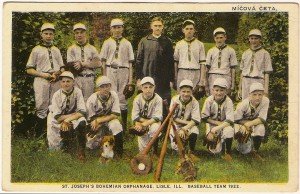In the first half of the 5th century BC the renowned ancient Greek poet Pindar wrote a number of odes commemorating victorious Olympic athletes. In one example he remarked:
For if any man delights in expense and toil
And sets in action high gifts shaped by the gods,
And with him his destiny
Plants the glory which he desires,
Already he casts his anchor on the furthest edge of bliss,
And the gods honour him.
Pindar’s words suggest that in addition to training and effort, an athlete required the favour of the gods in order to be victorious, and it was to Zeus, the father of the gods, that the games were devoted.
The first recorded Olympic Games was held in 776 BC. It was in that year that Koroibos of Elis won the stadion, a footrace that was initially the sole event at Olympia. It certainly wouldn’t have occurred to any of the spectators watching that race nearly 3000 years ago that these games would continue for over a thousand years, and eventually become the most important of all the sporting festivals in Greece. The unbroken record is extraordinary, considering the games were held every fourth summer despite wars and at times grave political troubles between the different Greek states. The initial stadion race was gradually joined by dozens of other events and increased to span five exhilarating days of contest in honour of Zeus, the god in whose religious sanctuary at Olympia the Games were held.
Over a millennium of Olympic Games might be a remarkable record, but even the prestige of Olympia declined with time and its religious significance clashed with other developing beliefs. The eventual demise of the Games came at the end of the 4th century AD as a result of Christian distaste for pagan rituals within the Roman Empire. The site of Olympia fell into ruin: its stadium, temples, treasuries and altars were deliberately destroyed and looted and whatever remained was quickly finished off by nature through earthquake and burial under river silt. Archaeologically speaking, it is fortuitous that swift destruction and burial such as that which occurred at Olympia are the ideal ingredients for excellent preservation. Much of the tumbled-down architecture, temple sculpture and reliefs, as well as the overall plan of the site survive for us to appreciate today. Even the marble starting line in the stadium is still in place, with parallel grooves cut for the toes to grip. These tangible remains are further revivified by the rich historical documents that still exist – lists of victors, engraved bases of winners’ statues, engraved dedications on equipment, the travel stories of Pausanias (around AD 150) and, as already mentioned, the odes of Pindar.
The archaeological treasures that lay buried under a green glade that was once Zeus’ major shrine were unknown for much of later history. Lost until 1766, the site was rediscovered and identified as Olympia by the British antiquary Richard Chandler. Chandler found it much as it is today, a fertile valley squeezed by the steep and tree-covered Mount Kronos into the elbow of two rivers – the Alpheios and its tributary the Kladeos. In the prehistoric period its verdant topography appears to have inspired the worship of nature gods – the spiritual origins of its rise to greatness as one of the glories of ancient Greece. It wasn’t until 1875 that the first German excavations (that continue today) were conducted; over time these have allowed scholars to piece together the jumbled but well-preserved remains of Olympia’s grandeur.
It is in the religious significance of the ancient Olympics that their essential difference from the modern secular Games lies. Out of the five days of each ancient Olympiad, almost every day involved religious ceremonies of some kind. Much of the first and last days were devoted to oaths and sacrifice, and the morning of the third day was dedicated to the procession of Hellanodikai (judges), ambassadors, and all competitors, followed by the sacrifice of 100 oxen given by the people of nearby Elis (who controlled Olympia). The centre of all this activity was the temple of Zeus and its altar nearby. It was in the temple that the olive wreaths won by the athletes as their prizes were dedicated in the presence of the enormous cult statue of Zeus. Featuring the god seated on a huge throne, the statue of sparkling gold and ivory towered over twelve metres in height. After its completion in about 430 BC, this masterpiece, created by the renowned sculptor Pheidias, became one of the seven wonders of the ancient world. For the athletes, there was surely no doubt whose support gave them the winning edge – it was Zeus himself.
But an estimated 40,000 people didn’t flock to Olympia for purely pious reasons; there were also great spectacles to be witnessed. Even so, the occasion was not without its discomforts, as the Games were held in the open during the hot month of July. The first-century AD writer Epictetus, in one of his Discourses, described the realities of attending an ancient Olympics:
Some unpleasant and hard things happen in life. – And do they not happen at Olympia? Do you not swelter? Are you not cramped and crowded?&Are you not drenched whenever it rains? Do you not have your fill of tumult and shouting and other annoyances? But I fancy that you bear and endure it all by balancing it off against the memorable character of the spectacle.
Clearly the Olympics were worth the effort, and of all the events, few were as spectacular or as popular with spectators as the various types of chariot races. Two- and four-horse chariots had been a feature of Greek life since at least the 14th century BC, and their uses for transport and war also extended to racing. A particularly dangerous variant was the race for apobatai. The apobates was a semi-naked warrior who would leap from a speeding four-horse chariot, run beside it for a distance, and then remount. Illustrated is a large marble base and a separate large fragment carved in relief and featuring a race by apobatai. Both date from around 400 BC and formed part of a votive relief dedicated to the gods for victory. The flowing cloaks and backward tilt of the athletes freeze the action of the dramatic moment just prior to their dangerous leap.
Combat sports were also popular with spectators, especially the now extinct pankration. This was a combination of boxing and wrestling, both of which were also competed for at Olympia. A pankratiast could hold his opponent whilst hitting him, and was only penalised for biting and gouging. The head of a victorious wrestler or pankratiast (c. 340 BC) found near the Gymnasium at Olympia would have been part of a statue of a winning athlete – an honour given to all those victorious at Olympia. Inevitably athletes in the combat sports suffered permanent injury and this is often evident in artistic depictions. By the time of the Hellenistic Period (323-27 BC), when art was striving to capture a sense of realism, we see cauliflower ears and scars. However, so distinctive are injuries within combat sports that even as early as 560 BC, during the late Archaic Period (c.660-480 BC), we can see on a boxer’s grave marker or stele his broken nose and swollen ear, sculpted at a time otherwise famous for its idealised representations.
Grave markers after 400 BC especially illustrate the ancient Greeks’ dedication to an ideal physical appearance. Young men are depicted on stelai as naked athletes within the gymnasion. We do not know how much the depictions differ from the real appearance and habits of the deceased, but bereaved relatives understandably wanted to represent their loved ones in a positive light. The nudity of the athletes on these markers is however realistic, since all sporting events were performed naked, as was all training (gymnasion itself means ‘to go naked’). The origins of this phenomenon are debated: one account suggests that Orsippos of Megara won the footrace at Olympia in 720 BC through the tactic of allowing his loincloth to fall off.
Painted ceramics also offer pictorial insights into Greek life. We are fortunate that the ancient potters found inspiration in their surroundings; scenes from everyday life, the theatre, industry, myths, and athletic competitions have all survived as decoration on vases. It is estimated that around one percent of ancient Greek ceramics from this time have survived. Considering their antiquity this is a relatively numerous amount, and we owe their survival to the fact that ceramics were often interred in graves as offerings to the dead. Examples of sporting scenes include those featured on vases related to the Panathenaic Games, held every four years as part of the festival to Athena. These games never achieved the status of the Olympic Games, but part of the prize included olive oil contained in an amphora decorated with the sport for which it was the prize.
The same conditions of deliberate burial that have contributed to the survival of ceramics have also ensured the survival of dedications made at sanctuaries of the gods, including Olympia. Over time it seems these dedications were gathered and buried in what archaeologists call ‘votive deposits’. Deity worship in ancient Greece consisted in the main of sacrifices and gifts (or dedications) to the gods. An offering reflected the wealth and status of the devotee – be it an individual or a city state – with all the varieties of quality, scale and material we would expect in a diverse and socially stratified society. Tangible dedications were a lasting and pious testimony in honour of the chosen god or cult. The variety of dedications includes miniature bronze athletes, sporting equipment, and bronze imitations of the god to whom the object was dedicated. Pieces from Olympia – such as a statuette of a runner – are often engraved with the words I belong to Zeus. Others carry details of the event, such as the bronze discus dedicated by Poplios Asclepiades at the 255th Olympiad in AD 241 [Olympia Museum]. Details like these make these objects all the more valuable in understanding ancient Greek religion and society.
Victorious Olympic athletes became heroes overnight and were commemorated by statues. Multiple winners such as the wrestler Milon or the pankratiast Theagenes were worshipped as heroes in the manner of the mythical hero Herakles. While it is true that little of monetary value was won directly though the games, the humble crown of olive leaves ensured great wealth and privileges were bestowed on the victor for the rest of his life. Wealth aside, the prestige of an Olympic victory was clearly a motivating factor for some participants – since kings and political tyrants were also known to have competed. The wealthy and powerful tyrant Hieron of Syracuse won the horse race in 476 BC, but achieved his main ambition in 468 BC when he won the chariot race. King Philip II won the horse race in 356 BC, and the chariot race in 348 BC. Philip II was so proud of his win he issued coins commemorating his victory in the synoris (two-horse chariot). At the time of this triumph, Philip had ambitions to conquer the world – a plan carried out after his death in 336 BC by his son, Alexander the Great. As an Olympic victor, the world had already advanced a step closer to being his, for Zeus had honoured him.





